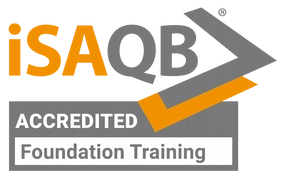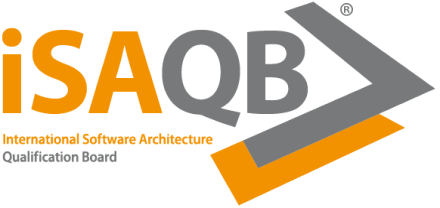Key Takeaways
- The iSAQB CPSA-A certificate can be described as a recognized qualification document for anyone working on solution structures in IT projects and wanting to expand their competencies in this area.
- The CPSA-A Certification allows you to make a significant leap in your career and stand out as a recognized professional in the field of software architecture.
- To enroll in the CPSA Advanced Level certification exam, you need to meet three basic requirements: first, you must have an iSAQB CPSA-F certificate. Second, you should have at least three years of work experience in the IT field. Lastly, you need to have earned at least 70 credit points in total, with no less than 10 credits in each of the 3 main qualification areas: communicative, methodical, and technical.
- The iSAQB CPSA-A exam includes multiple-choice questions, scenario-based analyses, and open-ended questions aimed at solving architectural design problems.
What is iSAQB CPSA-A Certificate?
The CPSA-A is the next level of certification after the CPSA-Foundation in the iSAQB® scheme. It helps software architecture professionals gain higher qualifications and take their abilities to the next level. Simply put, the iSAQB CPSA-A certificate is a recognized document certifying qualification for anyone working on solution structures in IT projects and aiming to broaden their skills in this field.
iSAQB has aimed to deepen knowledge in the fields of methodology, technology, and communication through an advanced training program. It achieves this with a modular training program that expects a wide display of skills and knowledge. By now, over 30,000 professionals worldwide have taken advantage of this top-tier training. This proves the recognition and success of the iSAQB and CPSA training among professionals and companies.
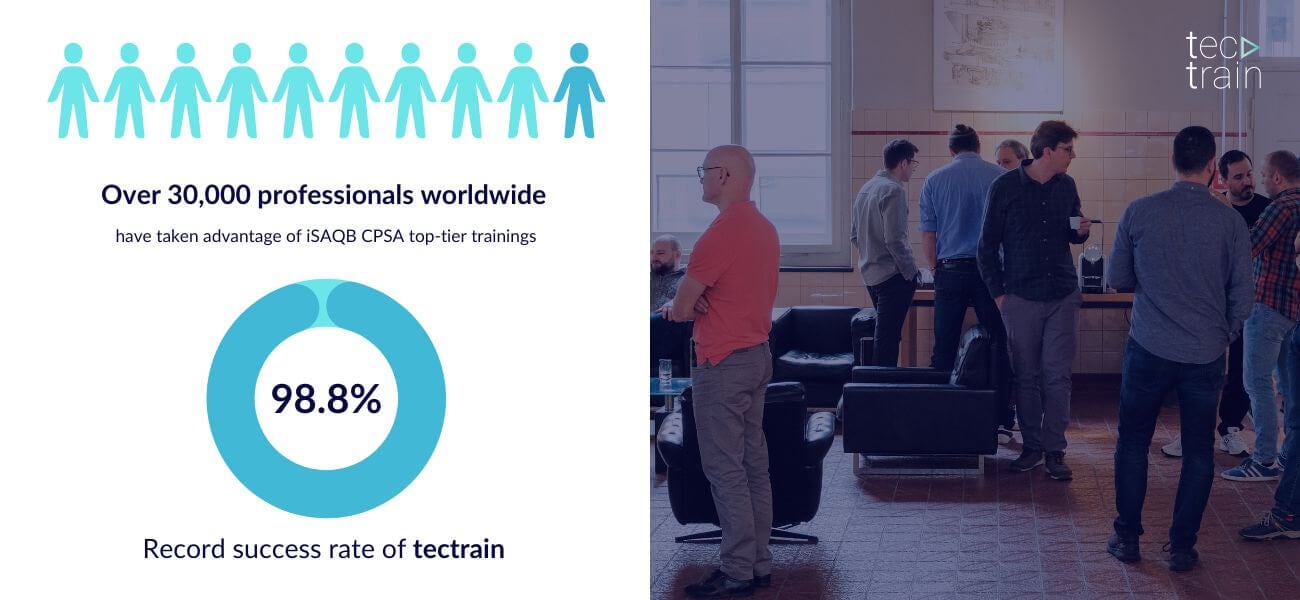
The CPSA-A program takes much longer time compared to the basic level training and imposes strict rules on the expertise and experience of its graduates. Finishing all steps to get the CPSA-A certificate and proving advanced knowledge accumulation sounds impressive, doesn’t it? But what benefits does obtaining this certificate offer? What kind of impact will it have? Why I should be an iSAQB-certified professional for software architecture at an advanced level?
Why you should get CPSA-A Certification?
It's a fact that today, both in the field of software architecture and globally across all sectors, the shortage of qualified workers is increasing. This situation leads companies to turn towards more talented employees, offering them better working conditions and higher salaries.
According to a study conducted in Germany, as of 2022, the number of employed people in the country is higher than ever before. A total of 41.741 million people are working, with 38.8 million in full-time positions and 6.5 million in part-time jobs. However, despite having so many employable individuals, many positions remain unfilled. The main reason for this is identified as the lack of qualified candidates.
Featured Source:
Skill Shortage is growing in Europe: New Case Study 2024
In this competitive environment, individuals need to step up and increase their value. This is where internationally recognized certifications from organizations like iSAQB come into play. The CPSA-A Certification offers an excellent path for those who want to specialize in software architecture and formalize their knowledge and skills in this area.
How? With the CPSA certification, you can master the latest technologies and best practices in software architecture. At the end of this process, where you will become familiar with the methods and techniques needed to develop high-quality software architectures, you can prove your expertise with an internationally recognized certificate.
Obtaining the CPSA-A Certificate clearly shows employers and clients how knowledgeable and skilled you are in your field. This certificate testifies to your serious accumulation of knowledge and expertise in this area.
Thus, in times when the shortage of qualified workers is felt, you become a more attractive job candidate. Additionally, it greatly contributes to your personal development, guiding you on your journey of continuous learning and self-improvement. In short, the CPSA-A Certificate enables you to make a significant leap in your career and stand out as a recognized professional in the field of software architecture.
What you’ll earn after CPSA-A certification?
With the iSAQB® CPSA Advanced Level Certificate, you can gain abilities such as:
- Independently and methodically designing medium and large-scale IT systems
- Taking on technical and content responsibility for IT systems of medium to high criticality
- Having the skill to design and document measures to implement non-functional requirements
- Accompanying development teams in the implementation of measures
- Directing and carrying out architecture-related communication in medium and large-scale development teams.
How to get a CPSA-A certificate?
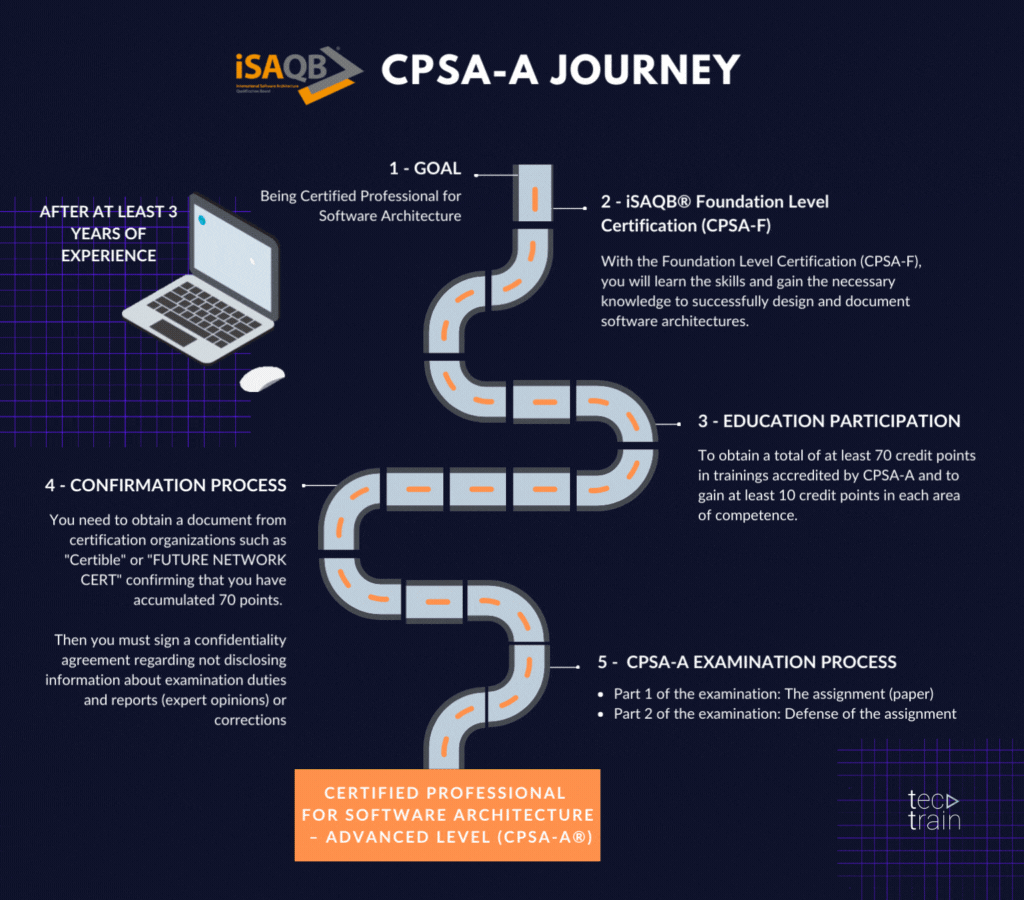
Requirements of the CPSA-A exam
We understand that the requirements for the CPSA-A exam can be a bit detailed and sometimes confusing. That’s why we aim to present them to you in the simplest and most understandable way possible.
Conditions to fulfill for accessing the iSAQB CPSA advanced level certification:
- Certificate: An iSAQB certificate for Software Architecture, Foundation Level.
- Professional Experience: At least three years of full-time professional experience in the IT sector. Participation in the design and development of at least two different IT systems.
- Activities and Overview of the Related IT Systems: A general overview in table form of the activities and related IT systems. A list of the main features in bullet points (system and project scope, industry, technologies, used products, frameworks, operating systems, methods, patterns).
- Training Participation: Participants receive a certificate by attending CPSA-A Advanced Level courses, and each advanced level course has a specific number of credit points. Participants wishing to enroll in the CPSA-A® exam must accumulate a total of at least 70 credit points and should cover 10 points for each of the following areas.
Certificates of participation are provided by accredited training providers.
In each iSAQB advanced module, there are 3 areas of competence where participants will later receive the relevant credit points. These are, in order:
Methodology: A systematic approach to architectural tasks, independent of the technologies used.
Technology: Knowledge and implementation of technology solutions used in design tasks.
Communication: The ability to effectively collaborate with different stakeholders, in addition to communication, presentation, discussion, and moderation skills.
Below are the iSAQB advanced-level courses and the credit points listed for each of the three areas of competence.
A total of at least 70 points must be collected from the three competency areas listed above. However, it is also required to collect a minimum of 10 points from each competency area.
For example;
A person attending the ADOK + AGILA + ARCEVAL courses completes 70 points with 60 points in the methodology area and 10 points in the communication area, but since they have "0" (Zero) points in the technology area, they do not meet the conditions.
In another example;
Individuals who attend the DDD + AGILA + CLOUDINFRA courses and qualify for certification achieve a total of 90 points with 50 points in the methodology area, 20 points in the technology area, and 20 points in the communication area, thus surpassing the 70-point threshold. At the same time, since they collect at least 10 points and above from each competency area, they qualify to take the CPSA-A exam.
- Confidentiality Agreement: A confidentiality agreement regarding not disclosing information about examination duties and reports (expert opinions) or corrections. A written consent declaration by the candidate that they will not transfer any tasks taken in the exam, any documents, models, papers, notes, reports created during the process (expert opinions), or corrections to any other person or organization.
This is a standard contract that imposes a penalty on the candidate in case of violation. This document can be obtained from the certifying organization.
CPSA-A Examination Process
After completing all the stages mentioned above, you need to obtain a document from certification organizations such as "Certible" or "FUTURE NETWORK CERT" confirming that you have accumulated 70 points. Then, an assignment for the exam will be sent to you. Now, let's get into the details of the exam itself;
The CPSA-A exam consists of 2 main parts:
- Part 1 of the examination: The assignment (paper)
- Part 2 of the examination: Defense of the assignment
Part 1: The assignment (paper)
Part 1 of the examination includes an assignment that can be completed with approximately 40 hours of work. Once received, this assignment must be completed within a 3-month timeframe. It can be submitted earlier than 3 months, but if you exceed this period, your exam will be considered invalid.
Part 1 of the examination, or the assignment paper, is thematically related to one or two of three system types: Information system, Web system, and Embedded system.
- Information System
Information systems are used in companies for data storage, processing, and reporting. Thanks to these systems, individuals in various roles work together towards a common goal. The system ensures the accurate storage, entry, and processing of data. They are typically used within companies' own networks (intranet), where user behavior is more regular and predictable.
These systems play a crucial role in managing complex business processes, but this can make it challenging to authorize users correctly. Information systems can also operate over the internet but are not directly defined as a "web system."
- Web System
Web systems function similarly to information systems but are accessible over the Internet. These systems are designed to accommodate a large number of users, variable internet traffic, and potential security threats. Since they operate over the Internet, these systems may be more susceptible to delays caused by slow network connections. Therefore, special attention is given to these types of challenges when creating web systems.
- Embedded System
Embedded systems are specialized computer systems that perceive their environment through sensors and interact with it through actuators. These systems are designed to measure and control the processes around them. Unlike others, the resources of these systems (such as memory, energy, and processing capacity) are limited, which must be considered in their design. Embedded systems are often used in situations that require fast response times and where timing is critical.
Participants can choose the system type that suits them from the types mentioned above. Additionally, after signing a confidentiality agreement for each task, they can receive two tasks from two different system types to choose from. After receiving their tasks, participants have three days to decide which task they want to work on for the exam and to inform the certifying organization of their decision.
Part 2: Defense of the assignment
After completing the first stage, the certifying organization assigns two independent evaluators to review the documented solution and deliver it to them for evaluation. The exam officials will then conduct an online interview or phone conversation with you.
In this conversation, namely the oral defense stage, you must explain, present, and defend your solution to the exam officials. If the reviewers confirm that you have met all the requirements for CPSA‑A®, that your solution is in accordance with the guidelines, and that you have well documented, explained, and defended your solution, it means you are eligible to receive the "Certified Professional for Software Architecture – Advanced Level (CPSA-A®)" certificate. The entire exam can be conducted in either German or English.
For detailed information, you can review the "Examination Rules Certified Professional for Software Architecture Advanced Level" document.
CPSA-A Examination Task (example)
Sharing information about the examination task is illegal. A confidentiality agreement signed by the candidate before the exam ensures that tasks received during the exam, any documents, models, papers, and notes, as well as reports created during the process (expert opinions) or corrections, are not transferred to other individuals or organizations. Therefore, we can't provide specific examples, but it's possible to illustrate based on an exam sample published on the iSAQB's official page.
You can find it here: Version 1.5, May 20, 2017 CPSA-A Final Task – BigSpender
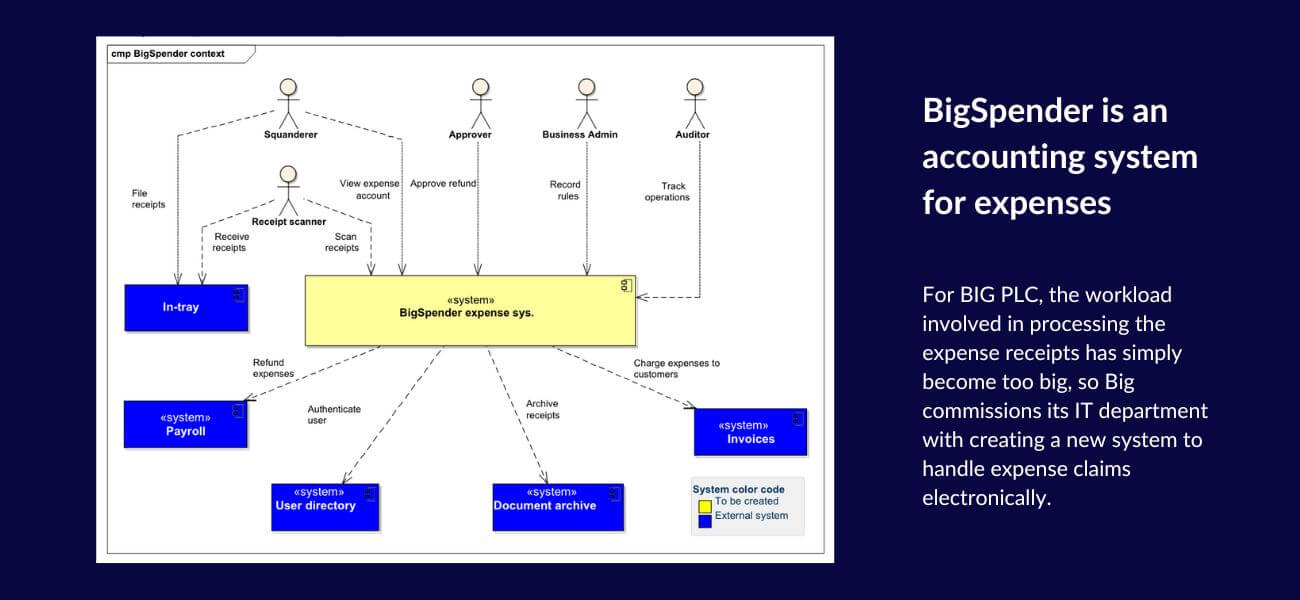
The CPSA-A exam's sample task "BigSpender" requires designing an information system aimed at automating the management of money spent by employees on business trips and other expenses. The system is conceived to cover the process from scanning expenses to their approval and payment. Additionally, this process must comply with audit requirements.
BigSpender is a project aimed at simplifying the expense management process. The system is expected to process expense receipts electronically, approve expenses, and pay these expenses along with employees' salaries. Moreover, it should ensure that expenses are billed correctly to the company's clients and allow auditors to examine each expense when necessary.
The exam typically includes multiple-choice questions, scenario-based analyses, and open-ended questions aimed at solving architectural design problems. Candidates are expected to have the analytical thinking and problem-solving skills necessary to design effective, efficient, and sustainable software architectures that meet the given business requirements.
The exam requires candidates to have not only theoretical knowledge but also a deep understanding of how to apply this knowledge in practical applications and real-world scenarios. Thus, the CPSA-A exam becomes a valuable certification for professionals wanting to pursue a career in software architecture.
During the design process, candidates need to solve a series of sub-tasks involving the system's quality requirements, solution strategy, technical context, business configuration, technology choices, and overall evaluation.
How much does it cost to get a CPSA-A certificate?
It seems you are asking about the total cost of obtaining the CPSA-A certificate after completing all the required stages.
We can explain the budget needed for the CPSA-A certificate in two different scenarios:
1- CPSA-A certification exam enrolling price
2- Total Cost from Scratch to CPSA-A Certificate
The information we are providing reflects the current prices as of April 2024, but please note that these prices may change when you read this article. For the most current price information for the CPSA-A Exam Fee, you can visit this link. Or, for the most up-to-date price information on all the certificates from scratch, you can check our iSAQB page.
1- CPSA-A certification exam enrolling price
The enrollment fee for the CPSA-A certification exam is 2,550.00 Euros plus VAT. If you need to retake the exam, the repeat fee will be 750.00 Euros plus VAT.
2- Total Cost from Scratch to CPSA-A Certificate:
If you do not yet have any CPSA certificates and you want to get the CPSA-A certificate, you will first need to obtain the CPSA-Foundation (CPSA-F) certificate and then complete the three different Advanced modules as detailed above. We can roughly estimate the cost of these modules as follows:
For example:
First, you obtain the CPSA-F certificate and then complete the ADOC + CLOUFINFRA + SOFT modules, accumulating a total of 80 CP and collecting at least 10 points from each competency area, then enroll CPSA-A certification exam.
- iSAQB® Foundation Level Training + CPSA-F Exam Fee: ~ 2000 €
- Example CPSA Module 1 - iSAQB® ADOC - Architecture Documentation Certification: ~ 1200 €
- Example CPSA Module 2 - iSAQB® CLOUDINFRA: ~1900 €
- Example CPSA Module 3 - iSAQB® SOFT - Soft Skills Certification: ~ 1800 €
- CPSA-A Certification Exam: 2,550 €
Total Cost: The total cost of these four training modules and the exam is ca. 9,450 € plus VAT.
These costs cover only training and exam fees. Our trainings are available in both online and onsite formats. For onsite training, study materials are provided by tectrain, and other potential expenses such as travel and accommodation are not included in this calculation.
Remember that prices can change, and you can find the most current information on our website.
Conclusion
The CPSA-A mandates candidates to go through a series of training and examination processes that assess whether they possess the qualities to demonstrate their abilities in designing system architecture, analytical thinking, and problem-solving.
Thanks to its lengthy and continuously self-improving modular structure, it rightfully earns its status as an internationally recognized certificate.
If you aim to establish yourself as proven Software Architects, Software Developers, or Other IT Professionals in the IT field, we are ready to support you on this path. We take pleasure in assisting and guiding you on your journey to success.






.jpg)
